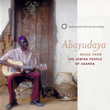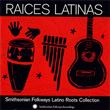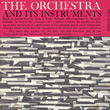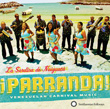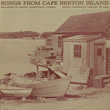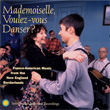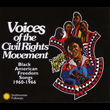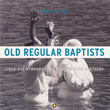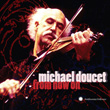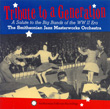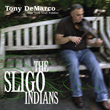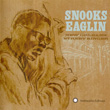Staff Picks
As a banjo player and ethnomusicologist, I was extremely grateful to have stumbled across this particularly brilliant album during my time here at Smithsonian Folkways. Bascom Lamar Lunsford was an Appalachian-born traditional musician and dancer, public lecturer and performer, spectator and promoter of musical contests, newspaper writer and editor, lawyer and college educated sophisticate. Lunsford made it his lifelong pursuit to—as he put it—"draw attention to the fine cultural value of our traditional music and our dancing and the fine honor of our people." With the addition of spoken introductions by Lunsford on selected tracks this album not only exemplified his exceptional banjo and singing style, but also the extent of his knowledge of each song's personal history. Hats off to Folkways for producing such a stunning showcase of the one and only "Minstrel of the Appalachians", Bascom Lamar Lunsford.
— Anders Fahey, Intern
I first heard this album when I was creating a playlist from Folkways' collection of Jewish music, and I was immediately struck by the familiarity of the songs, despite their unfamiliar setting. I grew up going to temple and singing the same words that the Abayudaya sing on this record, but in a markedly different place and style. The album is a beautiful and joyous collection of the music of Ugandan Jews, emphasized by choral singing, African rhythms, and Hebrew prayers. It is certainly one of my favorites in the Folkways catalog, and will be one that I come back to.
— Natalie Stearman, Intern
The Spokane Falls Brass Band is not your typical brass band. They have a unique appearance: they dress in turn-of-the-century garb and conduct themselves with a Victorian demeanor. They also have a unique sound: they are made up of two trumpets, two French horns, and a trombone. Further, their sixth member is a singer. This unusual instrumentation works very well for the group, though. The mellow sound of the horns provides a nice foundation for the soaring vocal talents of Ann Fennessy, and the chamber-like feel of the group results in a very clean and polished sound. Every time I listen to this album, I'm blown away by the virtuosity that these players perform with. The energy they brought to the recording in 1984 can still be felt and will keep you tapping your foot throughout.
— Elizabeth Wood, Intern
I love a good compilation for the same reason I love a good road trip: Music is a wonderful way to explore new places and people, and a Smithsonian Folkways collection never fails to take the listener on a cultural and musical journey. With 36 unique tracks, The Mississippi River of Song presents a fascinating, late 20th-century trip from the headwaters to the delta. From electric guitar to banjo strings, from edgy alternative rock to gospel, from Memphis blues to American Indian traditional music, this album is an incredible representation of contemporary American musical diversity.
— Shauna Vert, Intern
My love of Central American dance and traditional music may have come from my Panamanian heritage; however, the richness and depth of Latin American musical traditions far surpass what is present in any one culture. Raíces Latinas: Smithsonian Folkways Latino Roots Collection broadened my horizons and took me on an experience through the many identities of Central America, South America, and the Caribbean.
Music in Latin America features elements of the many cultures that have interacted over the course of history—European, African, and Amerindian. This album is an introduction to that vast diversity of musical expression. From South Texan conjunto to Argentinian tango criollo to Cuban son, this album provides the perfect start to an understanding and appreciation of Latino folk and traditional music.
As the first in the Tradiciones: Latino Music from Smithsonian Folkways series, it sets the stage for a collection that highlights various music styles throughout Latin America. If this series catches your interest, listen to samples with the Tradiciones Playlist.
— Corey Michael Blake, Intern
I’m drawn to extremes in music; give me more cowbell and I’m hooked. Every Smithsonian Folkways recording is a treasure, but for me Alfred Wolfhsohn’s recording Vox Humana: Alfred Wolfsohn’s Experiments in Extension of Human Vocal Range stands as a prescient document for the classical avant-garde.
In the wake of WWII, German teacher and psychologist Alfred Wolfsohn sought to breathe life into the human voice after witnessing first-hand how the War’s dictators had abused its galvanizing power. He also argued that while other musical instruments had evolved, vocal technique remained static. In this climate, he assembled his group Vox Humana?made up of men, women and a twelve year old boy?to explore the voice’s undiscovered qualities.
I have to admit that before I heard one guttural utterance I was drawn to the album for its kaleidoscopic cover. Then I noticed the liner notes featured an introduction by Henry Cowell, another Smithsonian Folkways artist and musical clairvoyant. Though the album is more a scientific document than an artistic statement, it holds together surprisingly well.
If you want to trace the roots of modern classical music, or simply increase your own vocal range one, two, or perhaps five octaves, listen to this dated, yet timeless recording of where vocal expression was and is still headed.
If this piques your interest, explore the other science and nature releases from Smithsonian Folkways.
— Jonathan Een Newton, Intern
This album represents what makes Folkways Records unique, and even risqué. Released during the height of the Cold War and when the United States had significant activity in Latin America, the protest songs on Cancion Protesta capture a part of history.
Some tracks are light and satirical and directly poke fun at the United States. “David and Goliath,” for example, compares the United States to Goliath and Cuba and Vietnam to David. Or there is “La OEA me causa risa,” in which singer Carlos Puebla taunts the listener with a laugh during each chorus.
If you don’t know Spanish, fear not, the soft melodies are enticing unto themselves. Set against the backdrop of the Spanish guitar they transport and relax.
The last two tracks on the album are by Silvio Rodríquez, perhaps Cuba’s best-known contemporary performer. Rodriguez was denied a visa to perform in the United States a number of times. In 2010, however, Rodriguez was allowed to perform in the United States for the first time in 30 years. He then performed in a number of cities across the nation, including here in Washington, D.C.
The Smithsonian Folkways cataloghas protest songs from all over the world?from Kenya to Chile, from Cuba to here in the United States.
— Emily Cohen, Intern
The tremendous capacity for expression, timbre, dynamic range and sheer beauty inherit in the symphony orchestra is such that it has captured the imaginations of composers and listeners alike for centuries. With such magnificent potential however comes a great deal of complexity and it is therefore no surprise that writing for?and even understanding?such a remarkable body on both an integrated and individual level is an altogether demanding and delicate process requiring a very particular set of skills and knowledge. Bearing this in mind, The Symphony Orchestra provides listeners with a rare insight into the unique craft of writing for such a collection of instruments by breaking down the instruments of the orchestra into a variety of combinations to accent the role of each instrument in the grand scheme of an orchestral score. For similar material, consider listening to Music Arrangement: Prepared by Vaclav Nelhybel - Musical Examples Played by Chamber Orchestra
— Kevin DeLeon, Intern
In my opinion, Josh White is often overshadowed in the discussion of the leading musicians of the Popular front era. I was lucky enough to learn about him in one of my history classes, even though he received only a few pages of attention in my textbook. Free and Equal Blues, recorded in the 1940s and released in 1998, is a tribute to this brilliant musician who combined the heartache of the blues, the swing of soul, and the feeling of folk into a music that defined one of the most politically active generations in our nation’s history (one that I desperately wish I could have been a part of). Elijah Wald, author of Josh White: Society Blues, captures how relevant White was during this time period in the liner notes. White’s lyrics were evocative about the disease of Jim Crow, and he became the voice for the African American community. His music was emblematic of Moses Asch’s mission to have music available of the people, by the people and for the people. If there’s one thing I can’t get enough of, it is the incredibly powerful sound of Josh White.
— Morgan Brown, Intern
In the coastal town of Naiguatá, popular festivals featuring music are part of the cultural tradition. La Sardina de Naiguatá drives these public celebrations with their music, performing during Carnival, Corpus Christi, St. John the Baptist, and other festivals. The group fuses traditional Afro-Caribbean rhythms with brass, electric bass, keyboard, and women’s chorus, an energetic combination that results in an overwhelming desire to dance that transports the listener to the street parades of Venezuela. Explore more world music from Smithsonian Folkways here.
— Megan Ryberg, Intern
With close ties to the novel and film Cold Mountain, this album serves as a real-life soundtrack to what one would hear on a journey through the back roads, woods, and trails of the Appalachian South during the Civil War era. These coal miners, Old Baptists, sacred harpists, banjo players, and fiddlers perform music learned through the oral tradition passed down from 19th century mountain settlers. The songs are simple and faithful, presented with a type of effortless magnitude as if the melodies were innate in those who sang them. Ballads of Civil War misery, love, and spirituality in a historic yet changing time can make the listener feel both isolated (like the rural communities that produced these songs) and also more in tune with a seemingly forgotten style of music, living, prayer, and landscape. For more mountain music, listen to Classic Mountain Songs from Smithsonian Folkways.
— Anias Stambolis-D’Agostino, Intern
The music of Cape Breton Island has particular importance for me. In 1899, my family settled in Glace Bay, Nova Scotia, not far from the now-closed Victoria and Sydney mines along the western limits of the Cabot Trail. My great-grandfather and his son would travel along the east coast of Canada buying fabric to bring home for dressmaking at their clothing shop. But as the mines shut down and business slowed, the family ended up in Toronto, Ontario. When my family came back to the island in the late 1990s for the first time in decades, all the locals still recognized my father and uncle as if they never left.
“Mo Run, Mo Nighean Dhonn Bhòidheach (My Love, My Pretty Brown-Haired Girl)” was recorded a short ferry ride from his hometown the year my dad was born. Though I have lived so far away from the island my entire life, listening to this music brings back all the stories I grew up with from my dad, uncle, grandparents, and cousins. Smithsonian Folkways has captured and preserved the sound of this small community of miners, fishermen, and shop owners on Songs from Cape Breton Island.
— Ely Rosenblum, Intern
Recorded during a four-year period in the northeastern U.S.A., this album opens listeners to the musical traditions of Franco-Americans in New England. The songs include old-time folk and bluegrass, dance songs, gypsy swing, chanson, and call-and-response tunes. Instruments include guitar, fiddle, mandolin, accordion, piano, upright bass, and the harmonica. The audible foot-tapping and group singing give the feeling of being in a bar full of musicians, and the informality of the recordings made me want to get up and dance and join in song. The melodies and harmonies are bright and uplifting, and this music represents a truly unique blending of cultures which is as rich in its history as it is in its style. Explore more French-Canadian folk traditions with singer Alan Mills on Folk Songs of French Canada.
— Massimo (Max) P. De Maria, Intern
Part of my affinity for Elizabeth Cotten may come from our shared home state, North Carolina, but the power of her unusual guitar style and the raw lyrics access the universal human experience. Freight Train, though written when she was only eleven years old, remains in my opinion one of the most emotional reflections on death ever put to music. Cotten is among the few female performers who are valued more for technical instrumental skills than vocal ability, a distinction I find admirable when women are more often considered primarily vocalists. Her style is intricate and flawless, and she expresses deep feeling through her layered self-taught picking as well as her mournful song choices. If you enjoy this album, you’ll also like Shake Sugaree, which Cotten recorded with her grandchildren.
— Maddie Howard, Intern
I am not religious, but when I first listened to this album, it was a spiritual experience. As many others have said before, music is like a religion in itself. For me, this is a prime example. Coming from Johns Island off the coast of South Carolina, these spirituals, folk tales, and children’s games reflect a culture and history unique to that area. The harmonies and sense of rhythm seem to be completely intuitive and innate. This album always inspires me to find things that are powerful and beautiful—something that seems to come out of nowhere, which in actuality existed long before I was even born.
— Carey McGovern, Intern
From the moment I first heard the powerful rhythms from “Cimarroneando,” I fell in love with joropo music because of its vibrant energy resonating through the instruments. These instruments include guitars, harps, drums, and maracas, which can bring a percussive effect to the listener’s ears. While the fast pace and waltz-style rhythm of joropo music make it suitable for dancing, the vocals are loud and heavy, telling stories of life along the Orinoco River. This type of music originated in the plains of Colombia, and has spread to western Venezuela. If you’re interested in listening to other forms of joropo music, or any other type of Latin American music in general, Smithsonian Folkways has a great collection of Latin American music called the Tradiciones/Traditions Series, which has around 200 albums from different countries in North and South America.
— Marian Lumba, Intern
After the recent dedication of the Martin Luther King Jr. National Memorial in Washington, DC, and the celebration of his birthday, a lot of talk about MLK has been circulating around the Smithsonian Folkways offices. This inspired me to go do some research, which turned up a wonderful Smithsonian Folkways album, Voices of the Civil Rights Movement: Black American Freedom Songs 1960–1966. The historical significance and powerful story of the African American experience awes me every time I listen to it. It is inspiring to see that Smithsonian Folkways has preserved such an integral part of U.S.A. history. If you would like to learn more, I would recommend reading the lesson plan “South Africa, Free at Last: The Freedom Songs of South Africa and the Civil Rights Movement in America”.
— Sarah Stierwalt, Intern
I first discovered the singing style of Old Regular Baptists from this 1997 Smithsonian Folkways release. The highly elaborated melodies twist and turn creating a beautiful heterophonic texture unlike anything I previously heard of. The raw singing style of the Old Regular Baptists is so powerful that I’m often left speechless when I listen. The liner notes that accompany the book give an in-depth look into the history and theology of Old Regular Baptists. It is a beautiful and fascinating tradition and I’m so glad Smithsonian Folkways has helped preserve it. If you’re interested in other singing traditions, I would recommend Fasola: Fifty-three Shape Note Folk Hymns: All Day Sacred Harp Singing at Stewart's Chapel in Houston, Mississippi.
— Stevie Feliciano, Intern
Michael Doucet, leader of the Grammy award winning Cajun band ‘BeauSoliel’, has recorded an album celebrating the rich traditions of the ‘roots’ music of Louisiana. Performing on the fiddle and octave violin, with one number each on the accordion and acoustic guitar, Doucet presents a savory gumbo of old and new Cajun, Creole, blues, gospel, and modern New Orleans funk. The album’s 19 tracks were recorded in three sessions; one solo, one with fiddle player Mitchell Reed, and one with guitarist Todd Duke. A personal favorite is a very soulful interpretation of Hoagy Carmichael’s “New Orleans”. If you listen closely, it is almost as if Doucet and Duke are channeling Stephane Grappelli and Django Reinhardt on this track. The mutual respect for the music and for each other as musicians is very much in evidence throughout. The music will get your feet tapping and your head bobbing. Music doesn’t get much better than this!
— J.B. Weilepp, Volunteer
These timeless standards performed by the Smithsonian Jazz Masterworks Orchestra make you want to get up and dance! A healthy helping of classics from Duke Ellington and the like make this album a big band fan’s dream. Each track on the album is a prime example of WWII era big band music — full of energy and swingin’ for sure.
— Kate Mullen, Intern
Kevin Burke shines as the leader on this album, his highly ornamented, vibrant, Sligo style smoothly guiding each melody. Yet what makes this record unique is that Burke and his fellow musicians, a group of old-timey musicians from New York, never edited these tunes. Their decision to keep the “live” recordings, thus preserving their experimental combination of musical styles, gives listeners a chance to hear one example of how Irish instrumental music has spread and evolved as musicians sit down together, share their music, and adapt their own techniques to blend with the stylistic heritage of another.
— Kaitlyn Myers, Intern
Tony DeMarco, a fiddler of Italian-Irish heritage, exemplifies nothing if not the diversity of Irish music in America. One of the best-loved musicians of the New York Irish music scene, he plays in the highly ornamented Sligo style with passion and finesse. Sligo Indians, his first solo album, represents the connections he has made throughout his 30 years of playing traditional music; it boasts a slew of star guest artists including fiddler Kevin Burke, guitarist John Doyle, piper Jerry O’Sullivan, and flute player Seamus Tansey. Presenting a range of traditional favorites as well as some of DeMarco’s own compositions, Sligo Indians is essential to any Irish music lover’s library.
— Miranda Pettengill, Intern
I first heard Snooks Eaglin on the Folkways album Classic Sounds of New Orleans. For this, his first album, Snooks Eaglin recorded without his band. The result is a collection of 16 stripped down blues and jazz standards he either taught himself or learned on the streets of his home city. His guitar work here is often improvisational and gives the record an impromptu feel that is substantiated by the fact that many of the songs were recorded in one sitting by University of Louisiana folklorist Harry Oster. A great record for anyone who likes B.B. King, Josh White, Big Bill Broonzy or Muddy Waters.
— Jon Wright, Intern
Debbie Martinez’s rich and sultry voice provides a beautiful harmony to the reverent lyrics on Dios, Familia y Tierra. Martinez employs the romantic sound of traditional Mariachi music to breathe new life into the ranchera (Mexican country) genre. The combination of her dynamic tenor and the musical arrangements of Lorenzo Martinez as masterfully interpreted by the Mariachi Tenapa makes this album a must have for anyone interested in Mexican-American folk music.
— Sandra Amolo, Intern
This recording comes from the Deori people of northeastern India, close to Bhutan. What strikes me most about the music is how both expansive and intimate it feels. The devotional and vocal strength of the people, the 10-minute tracks of pulsing drum work and insistent cymbals, all build into an awesome kind of overwhelming. At the same time though, the music has this honest, meditative quality, and in the quiet moments, you can sometimes even hear birds tweeting. Devotional Music of Assam is a part of Folkways’ ARCE (Archives and Research Center for Ethnomusicology) collection, which houses tons of ethnically diverse Indian music; so if you like this, I recommend checking out other ARCE releases too!
— Minna Zhou, Intern
The bare-bones, acoustic instrumentation in “A Grain of Sand” stands in sharp contrast to the politically-charged vocals of Nobuko Miyamoto and Chris Iijima. Their music is closely tied to their sense of identity. When their people became “Asian Americans,” marginalized for their perceived racial differences, the trio’s music became a way to express political unrest.
— Dan Singer, Intern
In 1960, Clarence Ashley had been out of the entertainment business for 20 years, and Doc Watson was an obscure electric guitar player in local country and rockabilly ensembles. Brought together by Ralph Rinzler, the two started performing in various settings across the USA, spurring Ashley’s comeback and launching Watson’s solo career in the wake of the urban folk revival of the 1960s. This two-disc collection chronicles their musical journey with recordings from concerts as well as back-porch family get-togethers.
— Linnea Jimison, Intern
Pete Seeger recorded Songs of Struggle and Protest on Folkways Records in 1964, just three years after testifying before the House of Un-American Activities Committee and during the height of his blacklist status. The songs have a rich history—some are written by Woody Guthrie and The Almanac Singers, a group of folk musicians who often sang for worker’s rights, and others hearken back to the Wobblies (The Industrial Workers of the World) who unionized in 1905. They are the very sorts of songs that got Pete blacklisted—songs of common humanity, struggle, and protest. He is known for having an enduring optimism and commitment, and the track “I Don’t Want Your Millions, Mister” illustrates Seeger’s unparalleled talent to lead a crowd in song. Detailed liner notes contain lyrics, historical, and contextual information for many songs. Before you listen, consider this quote from his trial transcripts: “I am proud of the fact that my songs seem to cut across and find perhaps a unifying thing, basic humanity.”
— Nichole Procopenko, Intern
Just gorgeous! This CD blew me away. In both contemporary and traditional compositions, solo or with great guest artists, Trischka offers music in a variety of styles, from uptempo to reflective; interesting tempos; and such virtuosic playing. My favorite tracks may be "Trompe l'oreille," "Zoe," "Sean," "Noah Came to Eden," and "Salt River" (which makes me want to get up and dance).
— Carla Borden, Editor
Barbara Dane and the Chambers Brothers combine the best of civil rights protest songs and the girl group sound and structure in this album, which perfectly epitomizes the sounds and struggles of the sixties. Dane is Fannie Lou Hamer, Aretha Franklin, and Bessie Smith all rolled in one, and her version of "It Isn’t Nice" is as catchy as it is powerful. Dane is extraordinary — a must-have!
— Heather Nelson, Intern
The late Dave Van Ronk was Bob Dylan's "first New York guru," he was the "musical Mayor of MacDougal Street" and "a walking museum of the blues," according to Dylan's biographer Robert Shelton. His generosity of spirit earned him friendship with artists such as Phil Ochs, Bob Dylan, Joni Mitchell, Mississippi John Hurt, and Christine Lavin. Dave Van Ronk left a deep mark, and after half a century of commitment to the blues, this October 2001 recording of his last concert features the incomparable "mayor" at his lively best.
— Dieger De Maeseneer, Intern
The story of Mississippi's Big Joe Williams may sound like blues myth—even legend—to a newcomer to the genre; however, any seasoned blues aficionado will tell you that Big Joe Williams is no tall tale, but in fact, "the real thing," as Pete Welding contends in the liner notes of this landmark album. A veritable road-warrior, Big Joe traveled the lands like Paul Bunyan with his equally mythical companion, his nine-string guitar, a hybrid beast assemblage played through an amplifier (jerry-rigged) with beer cans and pie tins. Listen to "King Biscuit Stomp #2" and note the comforting dissonance of Williams' growl atop his riveting licks all carried by the walloping rhythms of Ransom Knowling's bass. This album is truly relentless.
— John Van Paepeghem, Intern
For me, this is one of Folkways' most impressive albums because of the way it epitomizes America as a musical melting pot. This CD combines two LPs of Pete Seeger's from the 1950s and includes traditional American folk songs, European classical music, Irving Berlin, and some of Pete's own compositions. All tracks feature the 5-string banjo, an instrument with African origins. The recordings represent Pete Seeger's dedication to tradition as well as his innovativeness.
— Steven Saracco, Intern
Many people may remember reading about the Silk Road in world history classes from high school, recalling images of exotic merchants carting colored silks across Europe and through Inner Asia. This album shows that more than silk travelled on that road: the winds of trade tossed around a vast, rich, musical culture. Though many of these traditional performers are separated by hundreds of miles, their music is still united by the Silk Road, a thousand years later. The Silk Road: A Musical Caravan tells a story of human experience through beautiful music.
— Daniel Singer, Intern
I never knew how much Mary Lou Williams had contributed to jazz. She arranged for Duke Ellington. She went through every era of jazz. This is an example of really high art that is also accessible to my ears. After awhile, she pulled out of the jazz scene and helped recovering drug musicians—she housed them and fed them because after several prominent people died, like Charlie Parker, she felt like she had to do something for the musicians that were falling to this lifestyle. So it's interesting to learn about her personal life, as well as the music, through the extensive 30-page liner notes on Mary Lou Williams.
— Mary Alfaro, Intern
I first learned of Joe Hickerson and his band, the Folksmiths, in a course on North American folk music that I took in college. My class primarily learned about Hickerson because he founded the folk music club at my alma mater, Oberlin College, in the mid-'50s. His contributions to the world of folk music as a "song finder," songwriter, sales representative for Folkways, and longtime archivist at the Library of Congress, however, were enough to make me feel surprised that I had not heard of him before.
We've Got Some Singing to Do, the Folksmiths' only album, was the product of their tour of concerts and workshops across New England and the Mid-Atlantic during the summer after their graduation from Oberlin. It is a historic album as it includes the first recording of "Kum Ba Yah" by an American group.
— Raphael Bivas, Intern
We want to select forms of music that are more than music, but are symbols of identity and are touch-points of commonality, that work to build a stronger sense of community, whatever that community might be.
— Daniel Sheehy, Curator and Director
This albums kicks! It's great combination of the best of the past in Texas Mexican conjunto music and outstanding creativity and instrumental chops taking traditional to a high level of playing.
— Daniel Sheehy, Curator and Director
One of my favorite recordings was of Mrs. Marguerite Oswald, Lee Harvey Oswald's mother. Lee wrote a bunch of letters to her while he was living in Russia. It's a recording of her after the Kennedy assassination reading the letters. The fact that Moses Asch was willing to have them recorded and felt that that was something that needed to be archived really shows a lot about the catalog and Moses Asch.
— Joanna Fisher, Intern
Ralph Rinzler [founder of the Folklife Festival in 1967] went in September of 1960 to record Clearance Ashley at his daughter's house, and Ashley shows up with a band, including an electric guitar player. Ralph, being the folk purist, did not want anything to do with an electric guitar and he basically told him to get lost, he didn't want him there. That was Doc Watson. Later they were riding in a truck, and Doc picked up a banjo and started playing old-time music on it. He convinced Doc that people cared about the old stuff. Doc said: "Oh the old stuff! OK, that's what you want! OK we know some of that stuff."
— Jeff Place, Archivist
I like listening to the 37th Old Time Fiddler's Convention at Union Grove, North Carolina record. I've been attending this festival since I was a baby, and there's no other place on earth like it. Listening to the record makes me feel like it's Saturday night in late May and I'm sitting with my family on our quilt on the Grove under the trees watching the main stage performers, with kids playing by the honeysuckles to the left and musicians gearing up to hit the stage on the right.
— Elisabeth Beaver, Intern
I worked on the Flash animation for the Sarah Lee Guthrie album Go Waggaloo. While I worked, I would listen to the songs for inspiration while I designed. Sarah Lee Guthrie's voice is so soothing and calm. I always expect to not relate to children's music, but this is a great album that both parents and children can enjoy.
— Sandra Vuong, Web Designer
From the high lonesome sounds of Kentucky mountains to the high atmosphere of mountainous Kyrgyzstan, fiddles, Jew's harps, plucked-string instruments, and powerful voices ring out of highlands on opposite sides of the world.
— Mary Monseur, Production Manager
I became aware of Red Allen and Frank Wakefield via their influence on Jerry Garcia of the Grateful Dead and bluegrass group Old and In the Way. Jerry performed and recorded the music of Red Allen, Frank Wakefield, and other seminal voices in bluegrass, and was an emissary into the genre. These recordings for Folkways Records are examples of the powerful melodies, soaring harmony singing, and virtuosic instrumental solos that characterize the classic bluegrass sound, but also retain the spontaneity of a back-room jam session.
— David Horgan, Online Marketing Manager
Wade in the Water has so much music and I keep finding new ones that become favorites.
— Pam Rogers, IT Contractor
I think this is a brilliant record. Spoelstra was one of the few folk guys in the 60s who played on a 12-string. It's a classic of that era.
— Jeff Place, Archivist
This is the raw roots of the cumbia.
— Pete Reiniger, Sound Production Supervisor





 view cart
view cart

